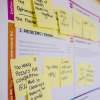UX design is about creating great experiences for your users. It’s also about ensuring every one of your users, regardless of their abilities and background, are able to use your product easily without feeling left out. This is what we call inclusive and accessible design.
The foundations of UX design have always been about empathy. And while you will find that a lot of inclusive or accessible design principles are things that you would normally incorporate in your products, there’s a big topic of best practices when it comes to making your designs as accessible and inclusive as possible.
Before I start, I would like to point out that inclusive and accessible design is not the same as universal design. A universal design is when you are designing only one variation of your product that will appeal and be usable for the biggest amount of people possible, of various abilities and background. Inclusive and accessible design may have multiple variations that would accommodate a diverse type of users.
What is inclusive design?
Inclusive design means designing accessible, usable, and welcoming experiences for people with different abilities, age, gender, race, nationality, background, and other defining characteristics. This approach means you will need to conduct extensive user research and empathise with a diverse set of users.
What is accessible design?
Accessible design means designing for people with disabilities, such as those with intellectual disabilities, hearing, visual, and motor impairments. Your design should make it easy for these individuals to understand, interact, and use your product by themselves or with assistance. Accessible design is considered a subset of inclusive design.
How to design for people with disabilities?
You should refer to the Web Content Accessibility Guidelines (WCAG) by the World Wide Web Consortium, the international body that sets internet standards. It is constantly updated and revised to keep up with new needs and the changing digital landscape. At the time of writing, the latest guideline version is the WCAG 2.2.
There are 4 principles that form the foundation of web accessibility, namely, perceivable, operable, understandable, robust. Some of your users with disabilities may be using your product without assistance while some may have a person assisting them.
Here are a few recommendations from the WCAG on each domain:
1. User input
The most common form of inclusive digital design takes place when a user input is required such as demographic information. You’ll want to include as many options as possible that cover as many people as possible, whether you are asking users to input their gender, name, race, or religion.
Most designers will include another option called “Others”, and then allow users to type in their answer when it isn’t available in the list provided. To take it further, you can provide a short explanation for each input box.
2. Imageries and videos
You should also be mindful of the visuals you use in your product. It’s good practice to include images of your target users, but don’t forget those who are considered minorities, who may turn out to be big users of your product.
You could tailor different visuals based on the user’s geo-location and other digital identifiers. Brands that consistently portray a diverse audience are more likely to have market longevity and a higher brand value.
3. Filters
For ecommerce, retail and hospitality brands, filters can become the bread and butter of your product especially if you have a huge inventory. After all, how would users buy or use your service if they can’t find what they want?
You’ll need to think like the people you want to appeal to. Think in the perspective of people of different ages, genders, and backgrounds. How would they search, and what would appeal to them?
4. Language
Be mindful of the tone, language and terms used when you’re writing out text. It’s not so much about political correctness, but more of writing in a way that is respectful to users’ different values, and empowering them to act. Avoid words, phrases or slangs that could imply biasness or discriminate against a group of people. Like it or not, your words have consequences, so choose them wisely.
Designing for inclusivity and accessibility is something that comes with experience. The more you do it, the more you understand and get the hang of it. It’s not just about changing the mindset of your teams, it’s also about ensuring the voices of each of your users are heard, so you can make proper adjustments to design the best product for them.







